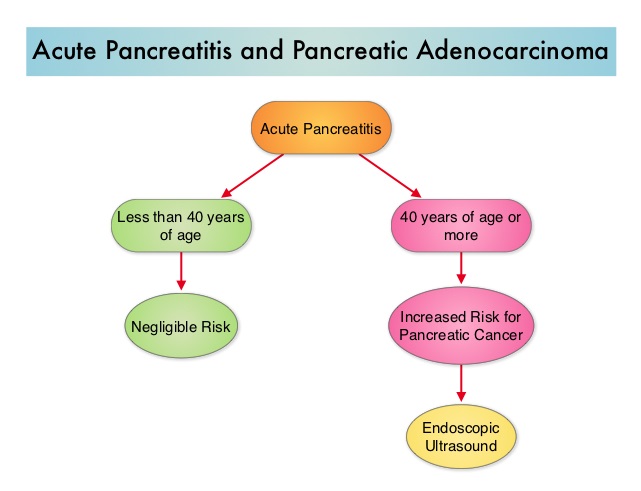SUMMARY: The American Cancer Society estimates that in 2014, over 46,000 people will be diagnosed with Pancreatic Cancer in the United States and close to 40,000 people will die of the disease. Some important risk factors for Pancreatic Cancer include increasing age, obesity, smoking history, genetic predisposition, exposure to certain dyes and chemicals, heavy alcohol use and pancreatitis. The best chance for long term survival is complete surgical resection, although this may not be feasible in a majority of the patients, as they present with advanced disease, at the time of diagnosis. Based on the National Cancer Data Base, the 5 year observed survival rate for patients diagnosed with exocrine cancer of the pancreas is 14% for those with Stage IA disease and 1% for those with Stage IV disease. Early diagnosis may therefore play an important role in treatment outcomes, in patients with Pancreatic Cancer. Pancreatic Cancer can cause acute pancreatitis by obstructing the pancreatic duct and patients diagnosed with Pancreatic Cancer often present initially with acute pancreatitis. With this background information, the authors performed a retrospective study of patients with acute pancreatitis who sought their medical care at the Veterans Health Administration from 1998 through 2007.  Patients with pre-existing Pancreatic Adenocarcinoma or those with recurrent acute pancreatitis were excluded from this analysis. A diagnosis of acute pancreatitis was made in 5720 patients and 710 patients were diagnosed with Pancreatic Cancer from 2000 through 2007. They noted that of those who were diagnosed with Pancreatic Adenocarcinoma, 76 patients (10.7%) had acute pancreatitis within 2 years of Pancreatic Cancer diagnosis. This risk for Pancreatic Cancer was greatest during the ï¬rst year following diagnosis of acute pancreatitis and this risk decreased rapidly thereafter. Patients less than 40 years of age had negligible risk whereas those 70 years of age or older had the highest risk. The authors concluded that a signiï¬cant number of patients with Pancreatic Adenocarcinoma (12.1%) initially present with acute pancreatitis and the diagnosis of cancer is often delayed by up to 2 years. Acute pancreatitis should be considered as an index event which in turn may identify a population of patients at high risk to develop Pancreatic Adenocarcinoma. They recommend that Endoscopic UltraSound (EUS) should be performed in these high risk patients, following diagnosis of acute pancreatitis, before discharge from the hospital, as this test is highly sensitive in picking up small tumors in the pancreas that are amenable to surgical resection. This is in comparison with contrast enhanced CT scans and pancreatic protocol CT scans that are not as sensitive in identifying tumors less than 2 cm in size. This interesting analysis could potentially open the doors for pancreatic cancer screening in high risk patients. Munigala S, Kanwal F, Xian H, et al. Clinical Gastroenterology and Hepatology 2014;12:1143-1150
Patients with pre-existing Pancreatic Adenocarcinoma or those with recurrent acute pancreatitis were excluded from this analysis. A diagnosis of acute pancreatitis was made in 5720 patients and 710 patients were diagnosed with Pancreatic Cancer from 2000 through 2007. They noted that of those who were diagnosed with Pancreatic Adenocarcinoma, 76 patients (10.7%) had acute pancreatitis within 2 years of Pancreatic Cancer diagnosis. This risk for Pancreatic Cancer was greatest during the ï¬rst year following diagnosis of acute pancreatitis and this risk decreased rapidly thereafter. Patients less than 40 years of age had negligible risk whereas those 70 years of age or older had the highest risk. The authors concluded that a signiï¬cant number of patients with Pancreatic Adenocarcinoma (12.1%) initially present with acute pancreatitis and the diagnosis of cancer is often delayed by up to 2 years. Acute pancreatitis should be considered as an index event which in turn may identify a population of patients at high risk to develop Pancreatic Adenocarcinoma. They recommend that Endoscopic UltraSound (EUS) should be performed in these high risk patients, following diagnosis of acute pancreatitis, before discharge from the hospital, as this test is highly sensitive in picking up small tumors in the pancreas that are amenable to surgical resection. This is in comparison with contrast enhanced CT scans and pancreatic protocol CT scans that are not as sensitive in identifying tumors less than 2 cm in size. This interesting analysis could potentially open the doors for pancreatic cancer screening in high risk patients. Munigala S, Kanwal F, Xian H, et al. Clinical Gastroenterology and Hepatology 2014;12:1143-1150

